St Andrew's Church
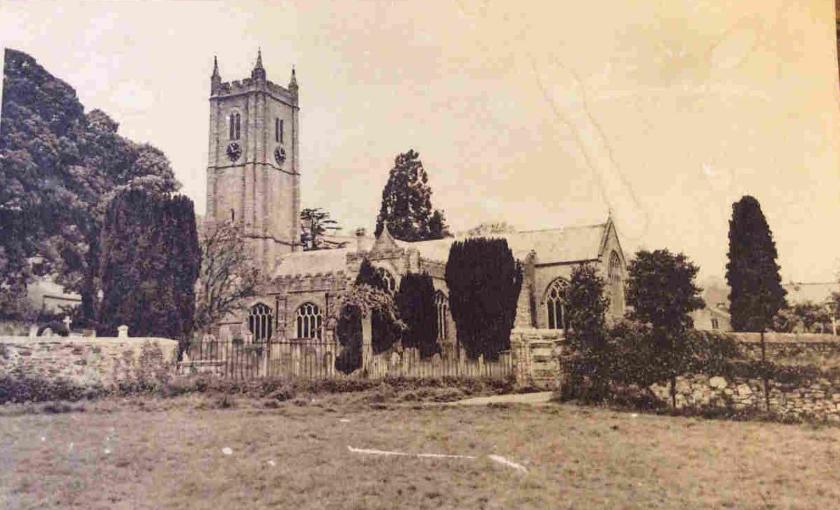
From the collection of Tereena Ravenscroft. Many thanks to Tereena for this photograph
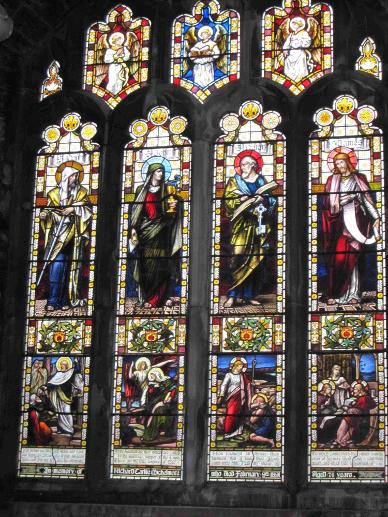
The report by Oakford Archaeology on the work inside St Andrew's in 2015 is available here:
http://archaeologydataservice.ac.uk/archiveDS/archiveDownload?t=arch-1137-1/dissemination/pdf/oakforda1-253599_1.pdf - Accessed 14-10-2017
My own photograph, 2014
A list of Ashburton vicars, provided by John Williams can be seen on the Ashburton pages of Genuki.
Slight alteration to the list: Joshua Bowdon was vicar in 1656. Sarah, the daughter of Joshua Bowdon, vicar of Aishberton, was borne 6 May 1656.
Parish records
http://genuki.cs.ncl.ac.uk/
* Early history *
The earliest record of the church dates back to the late 1100s, when John Le Chaunter, Bishop of Exeter (1186 - 91) gave it to the Dean and Chapter of Exeter Cathedral. 'The manor and church were then the personal property of the Bishop'.
Saint Andrew's Church Ashburton, A Guide and Short History, printed and publ by St Andrew's Church, 5th ed 2005/06
The document, probably in Exeter Cathedral reference D&C 610, is described as ‘Grant of Church to Chapter’ c.1186-91.
Thanks to Ellie Jones, archivist Exeter Cathedral, for this
Originally in Latin, Charles Worthy provided the following translation - bold lettering is mine :
"To all the faithful to whom the present writing shall come: John by Divine permission, the humble Minister of the Church of Exeter, Health is the author of Health. Your community should know that I (by divine intuition, and by the reverence of the blessed Apostles Peter and Paul as well as from consideration and honour of the Church of Exeter, to the care and responsibility of which, God assenting I am called) have given and yielded in pure and perpetual alms, to my beloved sons in Christ the Chapter of Exeter, the Church of Asperneton with all its belongings. Except an annual pension to the Nuns of Polslowe, which my predecessor of famous memory, Bartholomew Bishop of Exeter, gave and confirmed to them. In order that it may remain firm and unshaken I have confirmed it by placing of my seal to the present writing. These being the witnesses Walter of Cornwall, Roger of Barnstaple, Archdeacons, and many others"
Ashburton and its neighbourhood, Charles Worthy, L B Varder printer and publ., East St 1875 p xviii of appendix
* ******* *
D & C 3672A, quoted by Nicholas Orme, The Church in Devon 400-1560, Exeter 2013, p36
* ******* *
Dean and Chapter MS 3673, p23, quoted by C Fryer Cornelius in Report and Transactions of the Devonshire Association, vol 91, Ashburton, 1959, p46
In April 1314 Bishop Stapledon visited the church. His report, in latin, appears to be a long list of defects, and according to the St Andrew's Church guide his conclusion was that the church was delapidated; as a result he ordered various repairs, including that the north aisle be rebuilt* and a vestry be added.
A Guide and Short History, St Andrew's Church, 5th edition, p5
The Register of Walter de Stapledon, Bishop of Exeter, Rev F C Hingeston-Randolph, London & Exeter, 1892, p34
* 'Ala borealis ejusdem ecclesie est ruinous, et de novo construenda' ?
* ******* *
* 1400s and 1500s *
The Parish of Ashburton in the 15th and 16th Centuries as it Appears in Extracts from the Churchwardens' Accounts 1479-1580, London, 1870, p13
Charles Worthy, Ashburton and its neighbourhood, publ L. B. Varder, Ashburton 1875, p45
'The church is a respectable structure, built in the form of a cross, and having a handsome tower, ninety feet high, terminated by a small spire.'
http://standrewsashburton.co.uk
The Beauties of England and Wales, John Britton and Edward Wedlake Brayley, vol IV, London, 1803, p117
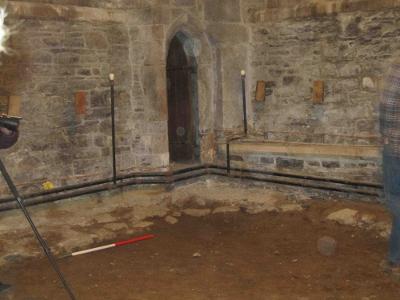
My own photograph 2015
Tot. Court Roll M41 Thursday after 13th January 1450, The History of Totnes Priory and Medieval Town, Devonshire, Hugh R Watkin, Torquay, 1914, vol 1, p407
In the 1400s the church had a spire:
in the period 1493 to 1494 John Bullocke, John Russell, Water Antoney,
Will Cllynche and Will Derte were paid 5s 10d for work about the spire
and making of scaffold. 9s 4d was paid for casting lead and soldering
about the spire, and John Cleffe was paid 8s 4d for ironwork. Will
Schabetor was paid 25s 8d for brasswork. Thomas Wilke painted the
'wether cocke' and charged 2s 8d.
Devon
and Cornwall Record Society, Churchwardens Accounts of Ashburton,
1479-1580, Alison Hanham, The Devonshire Press Ltd., Torquay 1970,
pp20,21
The Church also had a clock. Between 1497 and 1498 8d was spent on a new 'cord for le clocke'
Devon
and Cornwall Record Society, Churchwardens Accounts of Ashburton,
1479-1580, Alison Hanham, The Devonshire Press Ltd., Torquay 1970, p25
In 1489-90 Thomas Druyston was paid 12d for looking after the players' clothes, and in the next year's accounts John Soper earned 10d making players' clothes. In 1492-93 the players had 'bred and ale' at Corpus Christi, which cost 8d.
4 ratilbaggez* and vysers were bought for the players at the feast of Corpus Christi 1516-17. They cost 20d. In the same period John Soper received 2s 8d for keeping the players' finery, and an extra 10d for painting 5 wigs. Robin Whode [Hood] had a new tunic in 1526-27. Two years later staves were made for the players (6d), together with crests for their heads.
In 1533-34 2s was 'alowyd to the pleers of a Cryssmas game that pleyd yn the said churche.'
ibid pp xi,14,16,19,55,56,78,83,93
*Rattle bags. Hanhan says that 'devils' ran amongst the audience with these.
The Church in Devon, 400-1560, Nicholas Orme, Exeter 2013, p110
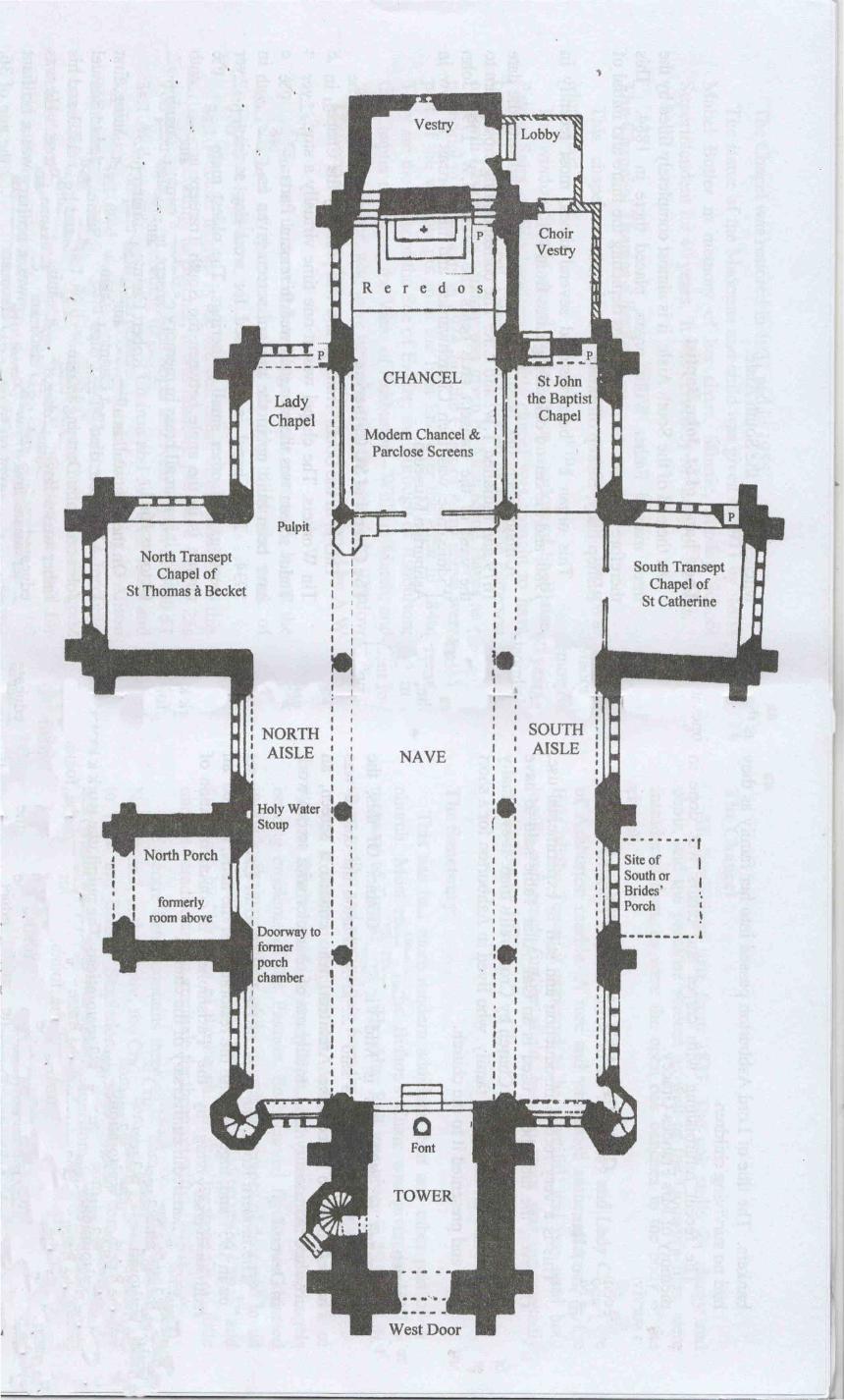
Right: Whether the path to the south side of the church was anything like this in the 1500s is anybody's guess, but I like to think of some Tudor brides making their way along something similar.
Below: Site of brides' porch, now a window (centre)
My own photographs 2016
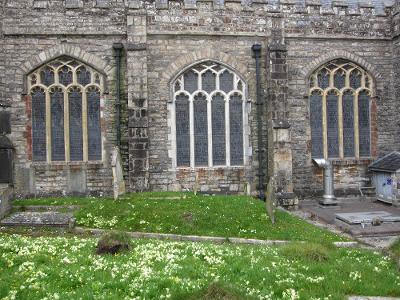
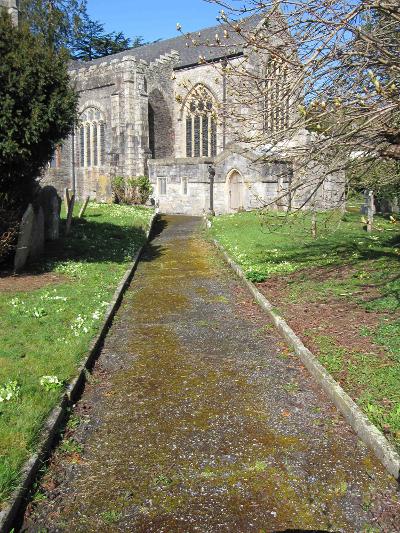
Expenses from the Churchwardens' Accounts:
1526-27
Costs and expenses to do with consecrating the church and cemetery after the assault on William Sampson by William Sowthe
Devon and Cornwall Record Society, Churchwardens Accounts of Ashburton, 1479-1580, Alison Hanham, The Devonshire Press Ltd., Torquay 1970, p78
1530-31
....And rope for tying pigs that came into the cemetery (2d)
ibid, p86
In 1540-41 5s 4d was paid 'for a new book called a bybyll.'
ibid, p107
From 1538 it was a legal requirement for every parish to buy a copy of the Bible in English (Henry VIII's 'Great Bible'), and put it in a place where it could be easily read. Cranmer's Bible of 1540 was a new edition with a preface by Thomas Cranmer, who was Archibishop of Canterbury.
http://www.bl.uk/learning/timeline/item101943.html - Accessed 23-12-2016
http://www.bl.uk/reshelp/findhelprestype/prbooks/earprintbib/earlyprintbib15351610/earlyprintedbibleseng1535.html - Accessed 23-12-2-16
1546-47
16d was paid for ringing the bells after King Henry VIII's death, 'on whose soul God have mercy'.
The priest who sang mass on that occasion was paid 4d for his breakfast.
Devon and Cornwall Record Society, Churchwardens Accounts of Ashburton, 1479-1580, Alison Hanham, The Devonshire Press Ltd., Torquay 1970, pp118/119
* ******* *
* Burials in the Church *
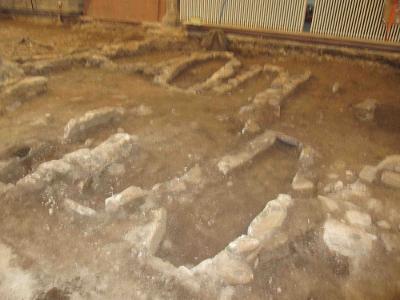
Early Secular Effigies in England, the 13th century, H A Tummers, 1980, Leiden, The Netherlands, p26
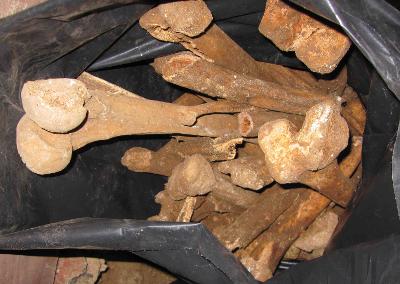
My own photographs 2015
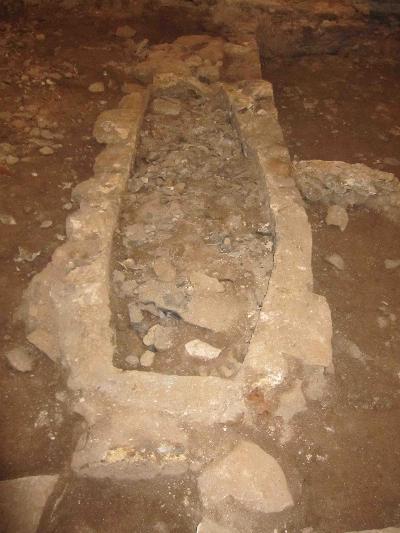
The 1700s
* The Pew Wars *
'Where any contention is about a seat in the body of the Church, upon complaint made to the Ordinary, he may decide the controversy, by placing the person in it whom he thinks fit; and this power is conferred on him by law, because he who hath the general cure of souls within his diocese, is presumed to have a due regard to the qualities of the contending parties, and to give precedence to him who ought to have it.............
.............should now any gentleman having a house in the parish, by the consent of minister, patron, and ordinary, build a new isle, and have a faculty from the bishop to hold the same, to the use of him and his family, to bury their dead in the said isle, and also to sit there, for the hearing of divine service, on condition constantly to repair it; this faculty would give him a good title to the said isle. '
Parish law, Joseph Shaw, printed by Henry Lintot, London, 1755, pp94/95
*******
Katherine L French says that Ashburton began selling seats in the church in 1489. Between that year and 1540 a hundred and fifty seven men (and twenty women) bought seats, and 36 of the individuals were churchwardens - most had purchased their seat before taking on the role. Further analysis of the social standing of the purchasers (which the author says is difficult because of the lack of supporting evidence) suggests 'that for some, seat purchasing was a step on the way to local prominence.'
The Good Women of the Parish, Katherine L French, University of Pennsylvania Press, 2008, p114
In 1684 Thomas, Bishop of Exeter, ordered the vicar and officers of Ashburton church to rearrange the pew allocations to reflect more accurately the status of the pewholders. A document in the Devon Heritage Centre lists all the pewholders and their allotted pews.
Ref DEX/9/a/1/Ashburton/1, June 27th 1684, Devon Heritage Centre
https://devon-cat.swheritage.org.uk/records/DEX/9/a/1/Ashburton/1
In the late 1760s and 1770s an argument arose in Ashburton over pews in the south aisle. The documents (in my possession) are hard to read, but the facts seem to be these:
Peter Woodley, of Halsanger Manor, had use of the pews (and the burial rights) in the south aisle.
Two men, John Edmonds and James Fursman wanted to build a pew or pews in the said aisle.
So what had to be decided (apart from the question of whether there was actually room) was whether the Woodleys had rights to the aisle at all, and if they did, whether it was to the whole aisle.
'In order to defend Mr Peter Woodley's right to the south aisle within the Parish Church of Ashburton in the County of Devon and objections why Mr John Edmonds, James Fursman ought not to erect or build seats or pews therein.
That the whole south aisle.....hath been from time beyond the memory of man belonged to the family of the Woodleys who lived at the Barton of Halshanger within the parish of Ashburton.........and always called or known by the name of Woodley's aisle.'
There then follows family details - of Peter Woodley's father and grandfather (both called Peter), and that he has a wife and six children, of whom four are grown. There also appears to be a claim that when his servants come to church they also sit in the same aisle.
'Mr John Edmonds ought not to have a seating (?) in this aisle for himself and his family being a young man lately married.......James Fursman ought not to have a seating (?) for himself and family having a wife only and no child whosoever.'
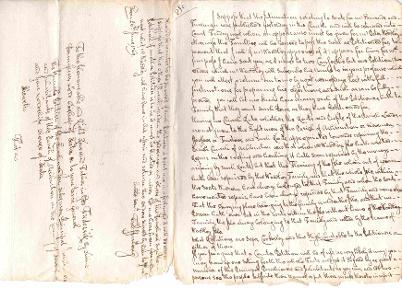
'The flooring of the aisle when out of repair hath been repaired by the Woodley family and that the whole aisle within the seats therein have always belonged to that family and when the seats have wanted repair have been always repaired by that family and no other.
That the burying place belonging to the family is under the aisle, and that no person hath ever sat in the seats within the aisle without leave of the Woodley family, the aisle always belonging to that family, and called by the name of Woodley's aisle.'
Various witnesses were called: Thomas Hamlyn, carpenter, was one of them.
'By virtue of a citation compulsory herewith shown unto you under seal of office you are cited to appear in the Cathedral Church of St Peter in Exeter in the consistorial court and place of indicature there on Tuesday the twentyfourth day of this ....April at the usual hour of hearing cause....on and there to take the oath usually taken by witnesses and to depose (?) the truth of what you know.....
.....you are not to fail under pain of the law and contempt thereof.'
Dated the fourteenth day of April 1770
Witness expenses had to be paid, as they were travelling to Exeter, usually for two days. It looks as though horses were hired at 5d (five old pence) a time - but two older parishioners, Hugh Smerdon and Mrs Catherine Harris had carriages on account of their age.
The following is an extract:
'1772 An.......of expenses that Mr Peter Woodley hath ...........to witnesses and otherwise in the cause of Edmonds
For a subpoena _ _ _ _ _ _ _ _ _ _ _ _ _ _
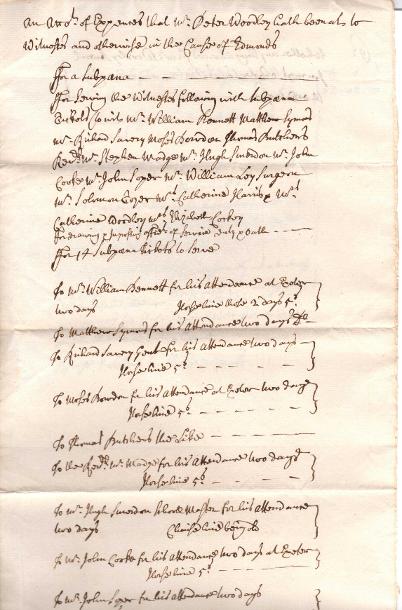
For serving the witnesses following with subpoena
.........Mr William Bennett, Matthew Symons, Mr Richard Sawry, Moses (?) Bowden, Thomas Pritchard, Rev W Stephen Madge, Mr Hugh Smerdon, Mr John Cooke, Mr John Soper, Mr William Loy* (?) surgeon, Mr Solomon Tozer, Mrs Catherine Harris, Mrs Catherine Woodley, Mrs Elizabeth Corley (?).......
..........
To Mr William Bennett for his attendance at Exeter
two days horse hire(?) .....2 days 5d
To Matthew Symons for his attendance 2 days
To Richard Sawry, gent for his attendance 2 days
horse hire (?) 5d
To Moses(?) Bowden for his attendance at Exeter 2 days
horse hire(?) 5d
To Thomas Pritchard (?)............
To the Rev. W Madge for his attendance at Exeter 2 days
horse hire (?) 5d
To Mr Hugh Smerdon schoolmaster for his attendance 2 days chaise him being old
To Mr John Cooke for his attendance at Exeter 2 days
horse hire(?) 5d
To Mr John Soper for his attendance at Exeter 2 days
horse hire(?) 5d
To Mr William Loy* surgeon for two journeys to Exon as a witness and horse hire } £02.02.00
To Mr Solomon Tozer as a witness two days and horse hire 5d }
To MrsElizabeth Corby (? Looks like Corley elsewhere in document) for her journey as a witness two days horse hire 5d }
To Mrs Catherine Harris for her attendance two days............hire up and down........& turnpike 1s(?) and 13s (?) being 70 years of age }
To Mrs Catherine Woodley for her journey as a witness two days horse hire 5d }
...........
* I now think this might be William Ley
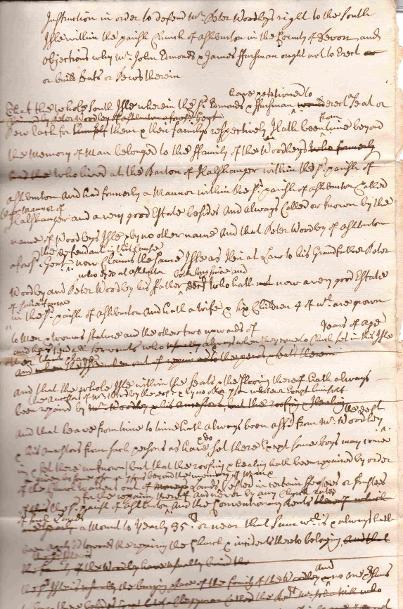
The next year, 1770, the vicar was writing to Richard Harris again. 'I observe that Fursman hath intruded into and sat in the ....seat in the Woodleys isle with an old man and that Edmonde's serv. maid hath likewise sat there and that Fursman says that Mr Upham ordered it so to be done.'
He
suggests 'I think that it will be advisable for Mr Woodley to take two
indifferent credible (?) persons with him to Fursman and the servant
Monday next in the forenoon whether they sit in the seat again too
morrow
Below: Part of another letter from Thomas Furlong to Richard Harris.
From my own collection
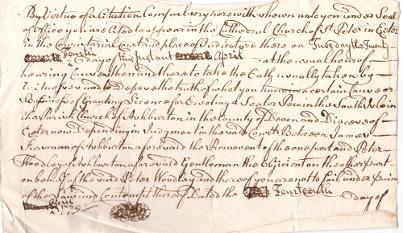
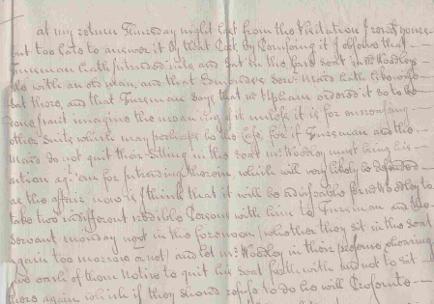
Exeter and Plymouth Gazette 20 April 1894 p6 col3
1775 When Thomas, the son of Thomas Lear, is buried in September, there is a note in the register: 'had a funeral sermon preached being the first in ye new pulpit by Mr. Savery (?)'
Parish records
Ashburton clergy in the Universal British Directory of Trade, Commerce and Manufacture, Vol 2, late 1700s:
Rev George Martyn
Rev Jonathan Palk
James Stoat , dissenting minister
Rev John White, Master of the Grammar School
*******
License of marriage between Alexander Laskey of Ilsington, clerk,
and Rebekkah Laskey of Yealmpton, spinster. Jan. 23rd, 1740.
Mar. Lie., Prin. Regy., Exon.
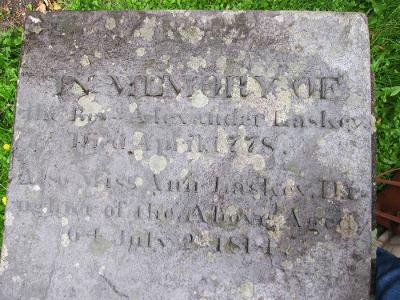
'Ashburton church having been reseated and freshly paved, was opened again for Divine service on Sunday 6th September 1776 ,and the present ugly pulpit and reading desk, of polished mahogany...were substituted for the ancient carved pulpit and brazen lectern, of which, we believe, the parishioners of Bigbury are now the fortunate possessors, and of which they are justly proud.
Ashburton and Its Neighbourhood, Charles Worthy, Ashburton, 1875, p26
'In [Bigbury] church is a very fine carved oak pulpit, like that of Holne, given by Bishop Oldham to Ashburton Church in or about 1510. At the same time he presented an owl as lectern to Ashburton Church, the owl being his badge. In 1777 the wiseacres of Ashburton sold pulpit and owl to Bigbury for 11 guineas. When the Bigbury folk saw that they had got an owl instead of an eagle they were disgusted, sawed off the head and sent it to Plymouth, with an order for an eagle's head of the same dimensions. Accordingly, now the lessons are read in the church from a lectern that has an owl's body with an eagle's head. '
A Book of the West, Sabine Baring-Gould, 1899, p345
'[The sale of the pulpit and lectern] was done when Sir Robert Palk returned from India and presented a most handsome three-decker pulpit, a marvel of joinery and teak which occupied the centre of the transept until a recent restoration swept that away also.'
Oak Carving at Ashburton in Tudor Days, Devon Notes and Queries, P F S Amery, 1900
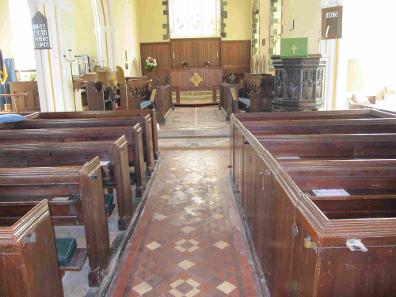
My own photographs, 2016
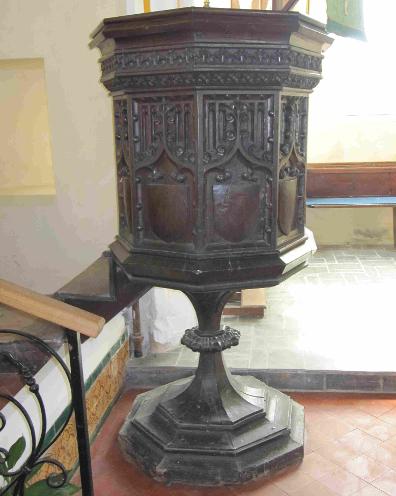
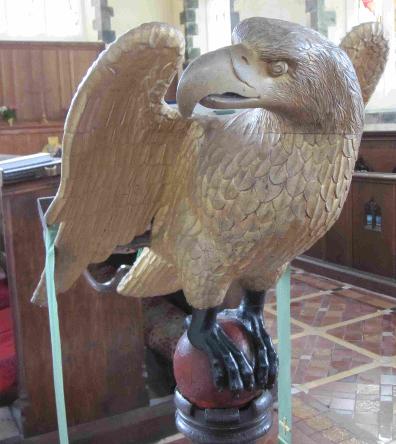
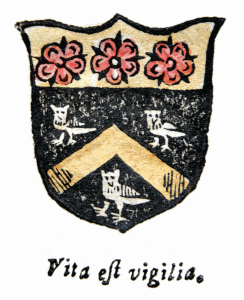
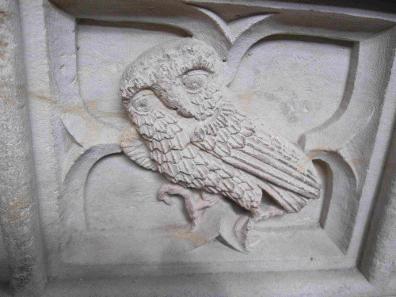
The 1800s
'The parish church.....is a fine specimen of the early perpendicular style, but has undergone many alterations and repairs.
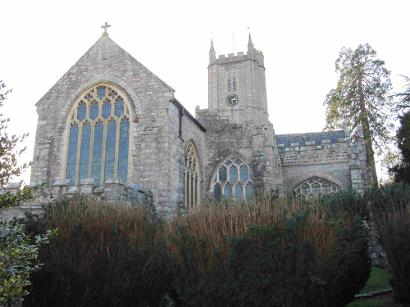
Above: St Andrew's Church
From my own collection
The Quarterly Theological Review and Ecclesiastical Record, 1825, Vol 2, p 521
In December 1833 it was reported that the nephew of the late Bishop Carey of Exeter had recently been appointed to the Ashburton living. This was despite the fact that he already held 'a very rich living in Cornwall'.
Western Times 14 December 1833 p5 col1
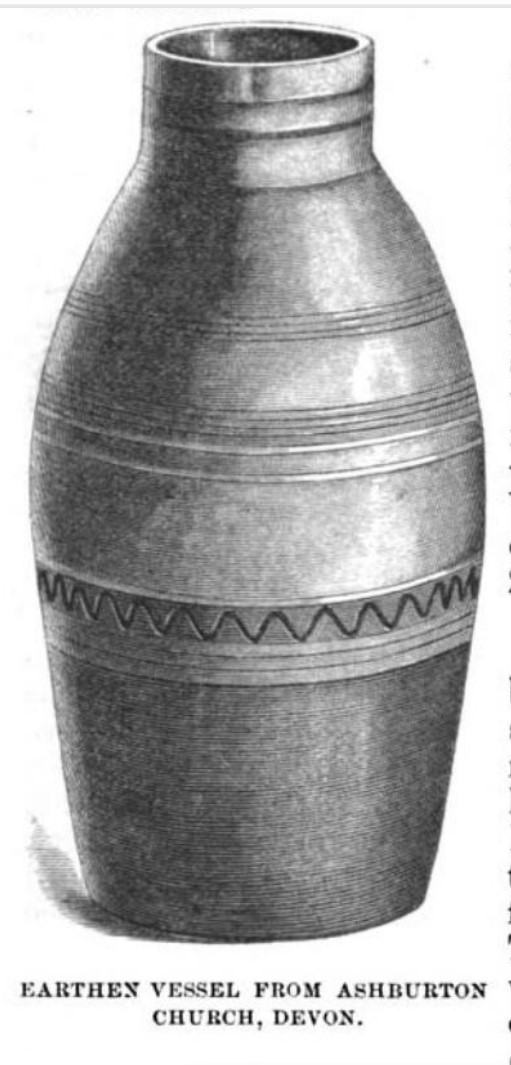
John S Amery, in the Transactions of the Devonshire Association in 1873, supports the theory that the vessels could have been acoustic jars, covered during the reformation. The pieces of slate were explained as an aid to plastering over the jars.
John S Amery, Transactions of the Devonshire Association, 1873, 203-205
It is thought that acoustic jars were used to enhance the sound quality in certain structures. Used by the Greeks and Romans in theatres, acoustic jars reappeared in medieval churches, but in an unsystematic manner. 'To this day, some two-hundred churches in Europe containing acoustic vases have been counted, half of which are in France'.
Marc Crunelle, Is There an Acoustic Tradition in Western Architecture? PDF http://www.wseas.us/e-library/conferences/skiathos2001/papers/102.pdf - accessed 17-08-2019
*******
As
a result of political meddling by the incumbent, the congregation
practically deserted the church during 1834 and 1835, with a large
number moving to the Wesleyan Chapel. At that time it was a 'small
building in one of the back streets'.
Western Times 5 May 1849 p5 col5
Western Times 21 February 1835
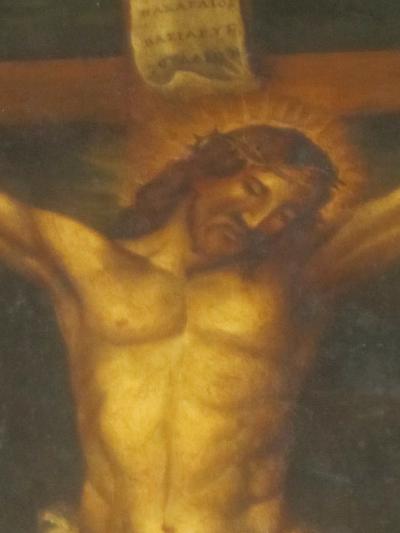
https://www.heritagegateway.org.uk/gateway/Results_Single.aspx?uid=MDV7876&resourceID=104 - Accessed 16-07-2020
Bridget Cherry and Nikolaus Pevsner, The Buildings of England, Devon, Penguin Books, 1952, p132
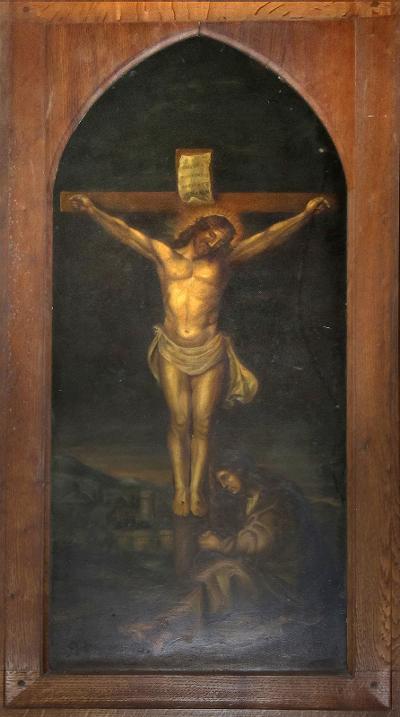
Salisbury and Winchester Journal, 20th September 1841
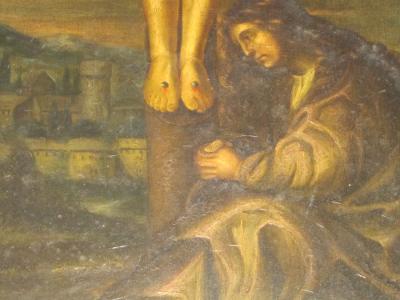
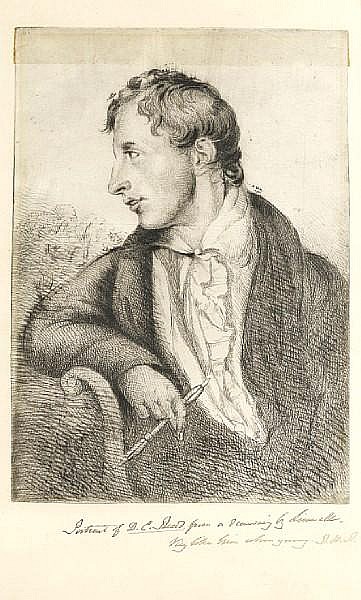
With thanks to G S.
Lee, Sidney, ed. (1896) Read, David Charles. Dictionary of National Biography. 47. London, Smith, Elder & Co.
ref PROB 11/2138/214 http://discovery.nationalarchives.gov.uk/checkout/receipt?orderKey=I%2F943825178006282W&paymentAmount=0&paymentCurrency=GBP&paymentStatus=0&mac=0 - accessed 19-07-2020
1844. The Rev C A Hunt had been a curate at Ashburton for 15 years. In May he was presented with a silver cup by the parishioners.
Western Courier, West of England Conservative, Plymouth and Devonport Advertiser, 22 May 1844, p4 col7
1857 Whilst praising the restored oak ceiling in the north aisle, the Western Times suggested that new seats would be of benefit to the church, instead of the current 'large sleeping boxes'.
Western Times 15 August 1857 p7 col3
The Rev W Marsh died on May 3rd 1861. He was said to have been the Vicar of Ashburton for 26 years.
Exeter Flying Post 8 May 1861 p5 col2
*******
Two new bells arrived in Ashburton in 1879, to add to the existing six. Cast by Messrs Blews and Son of Birmingham, they had a combined weight of 14cwt, and cost £100. The principal landowners of the parish had subscribed most of the money, but further donations were sought to pay for hanging the bells.
Western Times 5 August 1879, p8 col6
1879 The Rev A C Moorman, Independent Minister, was amongst those non-conformists welcoming the new vicar, the Rev W M Birch, to the town
Western Times 23 December 1879 p7 col4
The Rev. Wickham Birch was Vicar of Ashburton in the 1881 census. He was born 1830/31 Brusted (sic) Sussex. https://www.familysearch.org/
He was still the incumbent at the time of Queen Victoria's Golden Jubilee in 1887
Western Times 22 June 1887 p4 col2
*******
Exeter and Plymouth Gazette 13 November 1894 p2 col6
The 1920s
Those who could afford it conveyed their dead and the mourners in carriages, usually drawn by grey horses. However, one of my saddest memories of a funeral procession coming down North Street is of the coffin carried by six black clad bearers followed by the mourners walking slowly behind. All were clothed in black, the women crying and wiping their eyes with new white handkerchiefs contrasting starkly with their black garments. The pathetic little procession wended its way down North Street to the church or chapel. Shoppers stood respectfully silent as the cortège went on its tragic journey, men standing bare headed until it was out of sight. It was customary in the church for mourners to return on the Sunday morning following the funeral. A seat was reserved at the back of the nave and the deceased family occupied this pew and remained seated throughout the service. Great sympathy was expressed to the bereaved – one good soul was known for her sincerely expressed condolences, followed by 'I hopes you have a lovely day for the funeral.' A kindly thought as the cortège moved in procession to the grave and rain dripped from the trees on to black umbrellas: the weather seemed to add to the grief and depression of the family of the deceased.
Religious festivals played a great part in the life of the town. The Harvest Festival drew all the agricultural workers and farmers to the church which was lavishly decorated with autumn flowers and foliage, sheaves of corn and specially baked bread. There were vegetables and fruit in abundance and this was donated to the poor of the parish. St Andrew’s Church rang out with many harvest hymns as the farming community joined regular churchgoers in singing, “Come you thankful people come” and “We plough the fields and scatter the good seed on the land”.
The vicar and his wife were greatly respected, the church providing activities for children and young people. The church had parties at Christmas and the chapels had their anniversaries. Well-intentioned people gave up their time to run these activities and give a glimpse of a world outside Ashburton. The Congregational Chapel, known as “Great Meeting” had a stained glass window depicting the “Presentation of Jesus in the temple” on Candlemass Day, the graphic work of a Flemish artist. It is still in situ, but the chapel is no longer used for its original purpose. Church and chapels were at the centre of activities in the town.
The vicar’s wife was a delightful lady, of large proportions, she smiled genially and her love for children was obvious as she invited groups to tea on occasions, when some entertainment was arranged. She presided over the Sunday School, smiling benignly as she glided up and down the aisle of the church. Both the vicar and his wife had a vast fund of information about the church; she would suddenly turn and ask, 'Where can you see a pair of scissors?' To the baffled onlookers she would say 'That’s Dorcas, from the Acts of the Apostles. See the scissors hanging from her belt.' The vicar would look on, smiling fondly on his beloved wife. They were a devoted couple and were sadly missed when he was appointed to a position in Exeter Cathedral.
Life expectancy for the poor was comparatively short and, out of meagre wages, money was paid into an insurance policy for a funeral. It was a matter of pride that the deceased were put to rest respectably. In those days, cremation was not an option.
There was little mixing between church and chapel - the ecumenical movement was undreamt of and in many ways this divided the community. Early in the 1920’s people became familiar with the sight of two tonsured, black habited monks who walked in from the partially built abbey at Buckfast to deposit the money collected from curious visitors. A certain amount of suspicion and even hostility was felt locally until, with the passing of time, they were accepted as part of the community.
Thanks to Hazel Bray for the above item.
'At the age of 9 years I was admitted into St Andrew's Church Choir. Mr Harold O. Jones was organist and choirmaster, and the vicar was the Rev. R J Bond. I remained a chorister there for 74 years. In those days both the mens' and the boys' stalls were filled. Mr Jones maintained a high standard of music. He also founded and conducted the choral society. Every year he presented a concert, with London artists and the Royal Marine Orchestra. They were considered social events of the year. Occasionally the parish church would be used and an oratorio sung, for which the acoustics of our splendid church were well nigh perfect.'
From the memories of Reg Andrews, born 1893.
Many thanks to Dave Hodge-Brooks and Ernie Smerdon
From Kelly's Directory of Devonshire 1935:
Places of worship.
St. Andrew's Church, vicar - Rev E F Ball M A
Ashburton church bells were overhauled and re-hung in 1937. 'The peal was placed in the church in the middle of the 18th century to replace one which was lost at sea on its way to Ireland for recasting'. The seventh bell had been recast, with an inscription commemorating it being a coronation year.
Exeter and Plymouth Gazette, 23 April 1937, p15 col1
The 1940s
List of parishioners involved with the church. From the Ashburton and Buckland-in-the-moor parish magazine March 1946:
Vicar - Rev Gerald A B Jones B.A. Surrogate
Licensed worker - Sister Lloyd Mary
Churchwardens - Mr F Edgecombe, Mr. T K Islip.
Sexton and deputy clerk - Mr E G Rowland, 15 St Lawrence Lane.
Sidesmen - Mr W Bray, Mr H Burt, Mr G Clarke, Mr W T Coram, Mr H Cox, Mr A Davies, Mr W Furse, Mr H Hannaford, Mr H Hatch, Mr W T Lomax, Mr F C Matthews, Mr W H C Mugridge. Organist and choirmaster - Mr Harold O Jones
Choirmen - Mr F Edgecombe, Mr John J Tape, MR R S Andrews, Mr D Cowls, Mr W Eales, Mr A S D Caws, Mr F Turner, Mr C W Lamble, Mr H Bennett
Sacristan - Miss Butler.
Ringers - Mr F Baker (Capt), Mr Geo Edgecombe, Mr G Stone, Mr R Northway, Mr J Warren, Mr F Egbeer, Mr W T Coram, Mr J Davey, Mr J Baker.
Servers - J Butler, J Eales, E J Grimes, A Bawden, M King.
Representatives: Diocesan conference - Mr W T Lomax, Mr T K Islip
Ruridecanal conference - Miss Butler, Mssrs F Edgecombe H Hannaford
Parochial church council -
Elected - Mrs Blackler, Mrs Jones, Mrs Moulder, Rev M H Needham, Messrs R S Andrews, F Baker, C E Beavis, J Bray, H G Burt, A S D Caws, S Cowls, H H Cox, A Davies, W Furse, W H C Mugridge, R Stanbury,E H Varwell.
Sunday school superintendents: Senior - Mrs H O Jones
Middle - Miss Butler and Miss Blackler
Infants - Miss Butler
Mothers' union, enrolling member - Mrs Gerald Jones
Hon sec - Mrs H O Jones
Church decorators:
Font - Mrs Roberts
Windows in north and south aisles - Mrs Andrews, Mrs Berry, Mrs Davies, Mrs Hunt, Miss Armstrong
Lady Chapel window -Mrs Daymond
Screen -Mrs H Jones
S Catherine's chapel - Mrs Varwell
*******